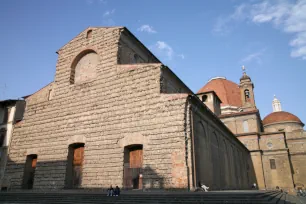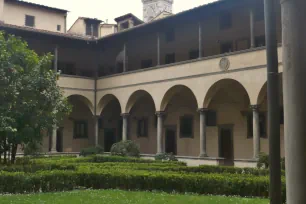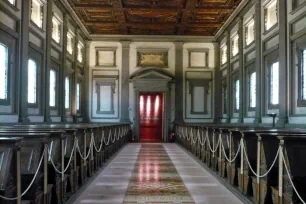The Basilica di San Lorenzo was the parish church of the Medici Family. Members of this wealthy and powerful family were entombed here. The church, originally designed by Filippo Brunelleschi in the fifteenth century, is an early example of ecclesiastical Renaissance architecture.
The Basilica di San Lorenzo is one of the oldest churches in Florence, and its origins can be traced back to the late Roman era. It was the parish church of Florence’s most powerful families, the Medici, who would for generations continue to embellish the church. Its current appearance goes back to 1419, when Giovanni de’ Medici (Cosimo the Elder) commissioned Brunelleschi with a reconstruction of the church. Brunelleschi died before the reconstruction was completed, and many other architects worked on the church, based on Brunelleschi’s original Renaissance design.
The Basilica
The basilica’s rough front facade is still incomplete. Michelangelo created a marble design for the facade, but it was never implemented. The Renaissance style interior however is elegant with white walls and gray columned arcades. Near the altar are two bronze pulpits, created by Donatello. It was his last work. After he died in 1466 the pulpits were completed by his students. A marble decoration in front of the altar marks the grave of Cosimo the Elder, the first of the Medici rulers.
Towards the left from the main altar is the entrance to the old sacristy, designed by Brunelleschi and built between 1422 and 1428. Donatello decorated the sacristy with beautiful colored stucco and reliefs.
Cloister and Laurentian Library
The cloister, built in 1462 by Manetti, has a formal garden planted with hedges and pomegranates. From here you can reach the Medici library, also known as the Bibliotheca Laurenziana or Laurentian Library. In 1523 Giulio di Giuliano de’ Medici, the later pope Clement VII, commissioned Michelangelo with the design of the library. Construction started in 1525, but Michelangelo left Florence in 1534 and the library was completed by several architects who followed Michelangelo’s design. One of the most original designs, a large staircase in the vestibule, was built by Ammannati in 1559. The reading room contains two sections of benches, also designed by Michelangelo.
The library owns an impressive selection of historic manuscripts and books originally collected by Cosimo the Elder and later expanded by other members of the Medici family. The collection includes invaluable items such as the eighth-century Codex Amiatinus (a bible) and the oldest version of the Naturalis Historia, a Roman encyclopedia. In 1571, Cosimo I de’ Medici opened the library to the public.

Medici Chapels
Most of the members of the Medici family are entombed in the Medici Chapels, which can be accessed from the Piazza Madonna degli Aldobrandini. A staircase leads to the Cappella dei Principi (Chapel of the princes). Six grand dukes are buried here under a large dome built by Buontalenti, reminiscent of Brunelleschi’s famous dome of the Florence Cathedral.

Decoration of the magnificent interior started in 1604, but it would take centuries before it was fully completed, with the final marble decoration added as late as in 1962. Sixteen coats of arms, representing the most important cities in Tuscany, decorate the chapel. Two niches contain statues of two grand dukes, Cosimo II and Ferdinando I. Plans to create statues for the other dukes were never realized.
The chapel is connected to the new sacristy, created by Michelangelo. Some of the artist’s most famous statues adorn the tombs of a son and grandson of Lorenzo Il Magnifico, who ruled over Florence during the second half of the fifteenth century. The sepulchral statues symbolizing Day and Night adorn the tomb of his son Giuliano, while the statues symbolizing Dusk and Dawn adorn the tomb of Il Magnifico’s grandson Lorenzo.
- Next: Uffizi
- More Sights & Attractions in Florence





